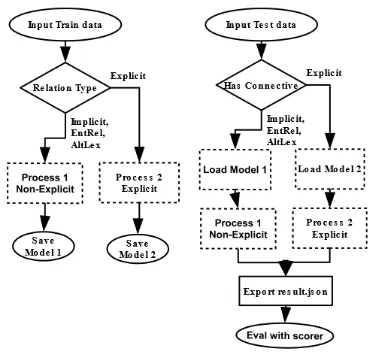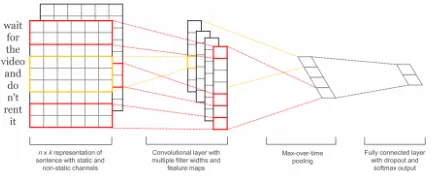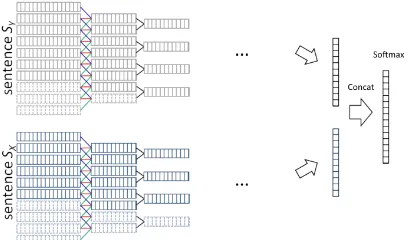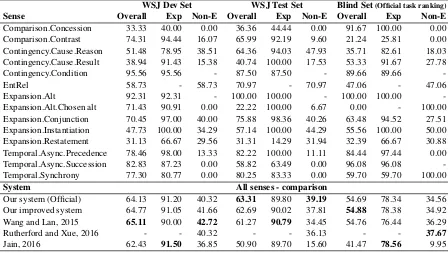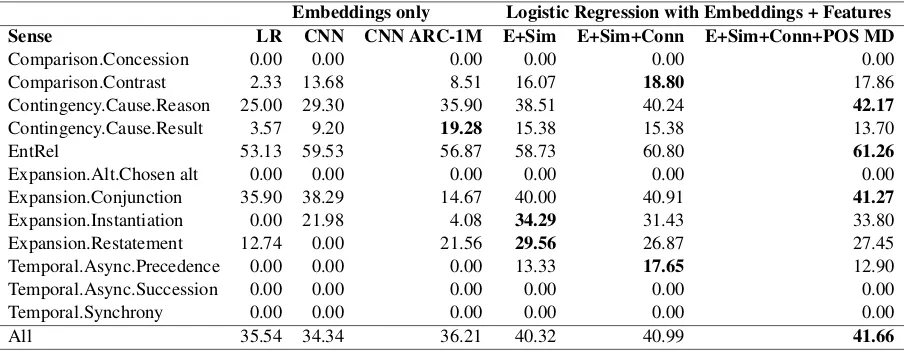Discourse Relation Sense Classification Using Cross-argument Semantic
Similarity Based on Word Embeddings
Todor Mihaylov and Anette Frank Research Training Group AIPHES Department of Computational Linguistics Heidelberg University, 69120 Heidelberg, Germany
{mihaylov,frank}@cl.uni-heidelberg.de
Abstract
This paper describes our system for the CoNLL 2016 Shared Task’s supplemen-tary task on Discourse Relation Sense Classification. Our official submission employs a Logistic Regression classifier with several cross-argument similarity fea-tures based on word embeddings and per-forms with overall F-scores of 64.13 for the Dev set, 63.31 for the Test set and 54.69 for theBlindset, ranking first in the Overall ranking for the task. We com-pare the feature-based Logistic Regression classifier to different Convolutional Neu-ral Network architectures. After the offi-cial submission we enriched our model for Non-Explicit relations by including simi-larities of explicit connectives with the re-lation arguments, and part of speech silarities based on modal verbs. This im-proved our Non-Explicit result by 1.46 points on the Dev set and by 0.36 points on theBlindset.
1 Introduction
The CoNLL 2016 Shared Task on Shallow Dis-course Parsing (Xue et al., 2016) focuses on iden-tifying individual discourse relations presented in text. This year the shared task has a main track that requires end-to-end discourse relation parsing and a supplementary task that is restricted to dis-course relation sense classification. For the main task, systems are required to build a system that given a raw text as input can identify arguments Arg1andArg2that are related in the discourse, and also classify the type of the relation, which can be Explicit,Implicit, AltLexorEntRel. A further at-tribute to be detected is the relationSense, which can be one of 15 classes organized hierarchically
in 4 parent classes. With this work we participate in the Supplementary Task on Discourse Relation Sense Classification in English. The task is to pre-dict the discourse relation sense when the argu-ments Arg1, Arg2 are given, as well as the Dis-course Connectivein case of explicit marking.
In our contribution we compare different ap-proaches including a Logistic Regression classi-fier using similarity features based on word em-beddings, and two Convolutional Neural Network architectures. We show that an approach using only word embeddings retrieved from word2vec (Mikolov et al., 2013) and cross-argument simi-larity features is simple and fast, and yields results that rank first in theOverall, second in theExplicit and forth in the Non-Explicit sense classification task. Our system’s code is publicly accessible1. 2 Related Work
This year’s CoNLL 2016 Shared Task on Shallow Discourse Parsing (Xue et al., 2016) is the second edition of the shared task after the CoNLL 2015 Shared task on Shallow Discourse Parsing (Xue et al., 2015). The difference to last year’s task is that there is a new Supplementary Task on Dis-course Relation Sense classification, where par-ticipants are not required to build an end-to-end discourse relation parser but can participate with a sense classification system only.
Discourse relations in the task are divided in two major types: Explicit and Non-Explicit (Im-plicit,EntRelandAltLex). Detecting the sense of Explicit relations is an easy task: given the dis-course connective, the relation sense can be deter-mined with very high accuracy (Pitler et al., 2008). A challenging task is to detect the sense of Non-Explicit discourse relations, as they usually don’t
1https://github.com/tbmihailov/
conll16st-hd-sdp - Source code for our Discourse
Relation Sense Classification system
have a connective that can help to determine their sense. In last year’s task Non-Explicit relations have been tackled with features based on Brown clusters (Chiarcos and Schenk, 2015; Wang and Lan, 2015; Stepanov et al., 2015), VerbNet classes (Kong et al., 2015; Lalitha Devi et al., 2015) and MPQA polarity lexicon (Wang and Lan, 2015; Lalitha Devi et al., 2015). Earlier work (Ruther-ford and Xue, 2014) employed Brown cluster and coreference patterns to identify senses of im-plicit discourse relations in naturally occurring text. More recently Rutherford and Xue (2015) improved inference of implicit discourse relations via classifying explicit discourse connectives, ex-tending prior research (Marcu and Echihabi, 2002; Sporleder and Lascarides, 2008). Several neu-ral network approaches have been proposed, e.g., Multi-task Neural Networks (Liu et al., 2016) and Shallow-Convolutional Neural Networks (Zhang et al., 2015). Braud and Denis (2015) compare word representations for implicit discourse rela-tion classificarela-tion and find that denser representa-tions systematically outperform sparser ones.
3 Method
We divide the task into two subtasks, and develop separate classifiers for Explicit and Non-Explicit discourse relation sense classification, as shown in Figure 1. We do that because the official evalua-tion is divided into Explicit and Non-Explicit (Im-plicit, AltLex, EntRel) relations and we want to be able to tune our system accordingly. During train-ing, the relation type is provided in the data, and samples are processed by the respective classifier models inProcess 1 (Non-Explicit)andProcess 2 (Explicit). During testing the goldTypeattribute is not provided, so we use a simple heuristic: we as-sume thatExplicitrelations have connectives and thatNon-Explicit2relations do not.
As the task requires that the actual evaluation is executed on the provided server, we save the mod-els so we can load them later during evaluation.
[image:2.595.323.508.62.241.2]For classifyingExplicitconnectives we follow a feature-based approach, developing features based on word embeddings and semantic similarity mea-sured between parts of the arguments Arg1 and Arg2 of the discourse relations. Classification is 2In fact, someAltLexdiscourse relations do have connec-tives, but they are consideredNon-Explicit. More detailed analysis will be required to improve on this simple heuristic. Given that their distribution across the data sets is very small, they do not have much influence on the overall performance.
Figure 1: System architecture: Training and eval-uating models for Explicit and Non-Explicit dis-course relation sense classification
into one of the given fifteen classes of relation senses. For detecting Non-Explicitdiscourse re-lations we also make use of a feature-based ap-proach, but in addition we experiment with two models based on Convolutional Neural Networks.
3.1 Feature-based approach
For each relation, we extract features fromArg1, Arg2 and the Connective, in case the type of the relation is consideredExplicit.
Semantic Features using Word Embeddings.
In our models we only develop features based on word embedding vectors. We use word2vec (Mikolov et al., 2013) word embeddings with vec-tor size 300 pre-trained on Google News texts.3
For computing similarity between embedding rep-resentations, we employ cosine similarity:
1−kuku.v.kvk (1)
Embedding representations for Arguments and Connectives. For each argumentArg1,Arg2and Connective(for Explicit relations) we construct a centroid vector (2) from the embedding vectorsw~i of all wordswiin their respective surface yield.
centroid(~w1...~wn) = n P i=1~wi
n (2)
3https://code.google.com/archive/p/
Cross-argument Semantic Vector Similarities.
We calculate various similarity features on the ba-sis of the centroid word vectors for the arguments and the connective, as well as on parts of the argu-ments:
Arg1 to Arg2 similarity. We assume that for given argumentsArg1andArg2that stand in a spe-cific discourse relation sense, their centroid vec-tors should stand in a specific similarity relation to each other. We thus use their cosine similarity as a feature.
Maximized similarity. Here we rank each word inArg2’s text according to its similarity with the centroid vector of Arg1, and we compute the average similarity for the top-rankedNwords. We chose the similarity scores of the top 1,2,3 and 5 words as features. The assumption is that the av-erage similarity between the first argument (Arg1) and the top N most similar words in the second argument (Arg2) might imply a specific sense.
Aligned similarity. For each word in Arg1, we choose the most similar word from the yield ofArg2and we take the average of all best word pair similarities, as suggested in Tran et al. (2015).
Part of speech (POS) based word vector sim-ilarities. We used part of speech tags from the parsed input data provided by the organizers, and computed similarities between centroid vectors of words with a specific tag fromArg1 and the cen-troid vector of Arg2. Extracted features for POS similarities are symmetric: for example we cal-culate the similarity between Nouns from Arg1 with PronounsfromArg2 and the opposite. The assumption is that some parts of speech between Arg1andArg2might be closer than other parts of speech depending on the relation sense.
Explicit discourse connectives similarity. We collected 103 explicit discourse connectives from the Penn Discourse Treebank (Prasad et al., 2008) annotation manual4 and for all of them construct
vector representations according to (2), where for multi-token connectives we calculate a centroid vector from all tokens in the connective. For every discourse connective vector representation we cal-culate the similarity with the centroid vector rep-resentations from allArg1andArg2tokens. This
4https://www.seas.upenn.edu/˜pdtb/PDTBAPI/
pdtb-annotation-manual.pdf - The Penn Discourse Treebank 2.0 Annota-tion Manual
results in adding 103 similarity features for every relation. We use these features for implicit dis-course relations sense classification only.
We assume that knowledge about the relation sense can be inferred by calculating the similarity between the semantic information of the relation arguments and specific discourse connectives.
Our featubased approach yields very good re-sults on Explicit relations sense classification with an F-score of 0.912 on the Dev set. Combining features based on word embeddings and similar-ity between arguments in Mihaylov and Nakov (2016) yielded state-of-the art performance in a similar task setup in Community Question An-swering (Nakov et al., 2016), where two text ar-guments (question and answer) are to be ranked.
3.2 CNNs for sentence classification
[image:3.595.309.525.501.591.2]We also experiment with Convolutional Neural Network architectures to detect Implicit relation senses. We have implemented the CNN model proposed in Kim (2014) as it proved successful in tasks like sentence classification and modal sense classification (Marasovi´c and Frank, 2016). This model (Figure 2) defines one convolutional layer that uses pre-trainedWord2Vecvectors trained on the Google News dataset. As shown in Kim (2014), this architecture yields very good results for various single sentence classification tasks. For our relation classification task we input the con-catenated tokens ofArg1andArg2.
Figure 2: CNN architecture by Kim (2014).
3.3 Modified ARC-1 CNN for sentence matching
Figure 3: Modified ARC-I CNN architecture for sentence matching.
tokens’ vector representations of Arg1 andArg2. Here, separate convolution and max-pooling lay-ers are constructed for the two input sentences, and the results of the max-pooling layers are concate-nated and fed to a single finalSoftMaxlayer. The original ARC-1 architecture uses aMultilayer Per-ceptronlayer instead of SoftMax. For our imple-mentation we use TensorFlow (Abadi et al., 2015).
4 Experiments and Results 4.1 Data
In our experiments we use the official data (En-glish) provided from the task organizers: Train (15500 Explicit + 18115 Non-Explicit),Dev(740 Explicit + 782 Non-Explicit), Test (990 Explicit + 1026 Non-Explicit), Blind (608 Explicit + 661 Non-Explicit). All models are trained onTrainset.
4.2 Classifier settings
For our feature-based approach we concatenate the extracted features in a feature vector, scale their values to the 0 to 1 range, and feed the vectors to a classifier. We train and evaluate a L2-regularized Logistic Regression classifier with the LIBLIN-EAR (Fan et al., 2008) solver as implemented in scikit-learn(Pedregosa et al., 2011). For most of our experiments, we tuned the classifier with dif-ferent values of the C (cost) parameter, and chose C=0.1 as it yielded the best accuracy on 5-fold cross-validation on the training set. We use these settings for all experiments that use the logistic re-gression classifier.
4.3 Official submission (LR with E+Sim)
Our official submission uses the feature-based ap-proach described in Section 3.1 for bothExplicit and Non-Explicit relations with all features
de-scribed above, except for the Explicit connective similarities (Conn) and Modal verbs similarities (POS MD)which have been added after the sub-mission deadline. Table 1 presents the results di-vided by senses from our official submission per-formed on the TIRA evaluation platform (Potthast et al., 2014) server. We also compare our official and improved system results to the best perform-ing system in the CoNLL 2015 Shared Task (Wang and Lan, 2015) and the best performing systems in the CoNLL 2016 Discourse Relation Sense Clas-sification task. With our official system we rank first in theOverall5ranking. We rank second in the
Explicitranking with a small difference of 0.07 be-hind the best system and fourth in theNon-Explicit ranking with more significant difference of 2.75 behind the best system. We can see that similar to (Wang and Lan, 2015) our system performs well in classifying both types, while this year’s win-ning systems perform well in their winwin-ning rela-tion type and much worse in the others6.
4.4 Further experiments on Non-Explicit relations
In Table 2 we compare different models for Non-Explicitrelation sense classification trained on the Trainand evaluated on theDevset.
Embeddings only experiments. The first three columns show the results obtained with three ap-proaches that use only features based on word embeddings. We use word2vec word embed-dings. We also experimented with pre-trained dependency-based word embeddings (Levy and Goldberg, 2014), but this yielded slightly worse results on theDevset.
Logistic Regression (LR). The LR column shows the results from a Logistic Regression clas-sifier that uses only the concatenated features from the centroid representations built from the words ofArg1andArg2.
CNN experiments. The CNNcolumn shows results obtained from the Convolutional Neural Network for sentence classification (Section 3.2) fed with the concatenatedArg1andArg2word to-kens’ vector representations fromWord2Vecword embeddings. For our experiments we used default 5Overallscore is the F-score on All (both Explicitand
Non-Explicit) relations.
WSJ Dev Set WSJ Test Set Blind Set(Official task ranking) Sense Overall Exp Non-E Overall Exp Non-E Overall Exp Non-E
Comparison.Concession 33.33 40.00 0.00 36.36 44.44 0.00 91.67 100.00 0.00 Comparison.Contrast 74.31 94.44 16.07 65.99 92.19 9.60 21.24 25.81 0.00 Contingency.Cause.Reason 51.48 78.95 38.51 64.36 94.03 47.93 35.71 82.61 18.03 Contingency.Cause.Result 38.94 91.43 15.38 40.74 100.00 17.53 53.33 91.67 27.78
Contingency.Condition 95.56 95.56 - 87.50 87.50 - 89.66 89.66
-EntRel 58.73 - 58.73 70.97 - 70.97 47.06 - 47.06
Expansion.Alt 92.31 92.31 - 100.00 100.00 - 100.00 100.00
-Expansion.Alt.Chosen alt 71.43 90.91 0.00 22.22 100.00 6.67 0.00 - 100.00 Expansion.Conjunction 70.45 97.00 40.00 75.88 98.36 40.26 63.48 94.52 27.51 Expansion.Instantiation 47.73 100.00 34.29 57.14 100.00 44.29 55.56 100.00 50.00 Expansion.Restatement 31.13 66.67 29.56 31.31 14.29 31.94 32.39 66.67 30.88 Temporal.Async.Precedence 78.46 98.00 13.33 82.22 100.00 11.11 84.44 97.44 0.00 Temporal.Async.Succession 82.83 87.23 0.00 58.82 63.49 0.00 96.08 96.08 -Temporal.Synchrony 77.30 80.77 0.00 80.25 83.33 0.00 59.70 59.70 100.00
System All senses - comparison
Our system (Official) 64.13 91.20 40.32 63.31 89.80 39.19 54.69 78.34 34.56 Our improved system 64.77 91.05 41.66 62.69 90.02 37.81 54.88 78.38 34.92 Wang and Lan, 2015 65.11 90.00 42.72 61.27 90.79 34.45 54.76 76.44 36.29
Rutherford and Xue, 2016 - - 40.32 - - 36.13 - - 37.67
[image:5.595.74.522.63.316.2]Jain, 2016 62.43 91.50 36.85 50.90 89.70 15.60 41.47 78.56 9.95
Table 1: Evaluation of our official submission system, trained on Train 2016 and evaluated on Dev, Test and Blind sets. Comparison with our official system and our improved system with the official results of CoNLL 2015 Shared task’s best system (Wang and Lan, 2015) and CoNLL 2016 Shared Task best systems inExplicit(Jain, 2016) and Non-Explicit (Rutherford and Xue, 2016). F-Score is presented.
system parameters as proposed in Kim (2014): fil-ter windows with size 3,4,5 with 100 feature maps each, dropout probability 0.5 and mini-batch of size 50. We train the model with 50 epochs.
CNN ARC-1M experiments TheCNN ARC-1Mcolumn shows results from our modification of ARC-1 CNN for sentence matching (see Section 3.3) fed withArg1 andArg2word tokens’ vector representations from the Word2Vec word embed-dings. We use filter windows with size 3,4,5 with 100 feature maps each, shared between the two ar-gument convolutions, dropout probability 0.5 and mini-batch of size 50 as proposed in Kim (2014). We train the model with 50 epochs.
Comparing LR, CNN and CNN ARC-1M ac-cording to their ability to classify different classes we observe that CNN ARC-1M performs best in detectingContingency.Cause.Reasonand Con-tingency.Cause.Result with a substantial margin over the other two models. The CNN model outperforms the LR and CNN-ARC1M for Com-parison.Contrast,EntRel,Expansion.Conjunction and Expansion.Instantiation but cannot capture anyExpansion.Restatement which leads to worse overall results compared to the others. These in-sights show that the Neural Network models are
able to capture some dependencies between the re-lation arguments. ForContingency.Cause.Results, CNN ARC-1M even clearly outperforms the LR models enhanced with similarity features (dis-cussed below). We also implemented a modified version of the CNN ARC-2architecture of Hu et al. (2015), which uses a cross-argument convolu-tion layer, but it yielded much worse results.7 LR with Embeddings + Features The last three columns in Table 2 show the results of our feature-based Logistic Regression approach with different feature groups on top of the embedding represen-tations of the arguments. ColumnE+Sim shows the results from our official submission and the other two columns show results for additional fea-tures that we added after the submission deadline. Adding the cross-argument similarity features (without the POS modal verbs similarities) im-proves the overall result of the embeddings-only Logistic Regression (LR) baseline significantly from F-score 35.54 to 40.32. It also improves the result on almost all senses individually. Adding Explicit connective similaritiesfeatures improves the All result by 0.67 points (E+Sim+Conn). It also improves the performance on
Embeddings only Logistic Regression with Embeddings + Features
Sense LR CNN CNN ARC-1M E+Sim E+Sim+Conn E+Sim+Conn+POS MD
Comparison.Concession 0.00 0.00 0.00 0.00 0.00 0.00
Comparison.Contrast 2.33 13.68 8.51 16.07 18.80 17.86
Contingency.Cause.Reason 25.00 29.30 35.90 38.51 40.24 42.17
Contingency.Cause.Result 3.57 9.20 19.28 15.38 15.38 13.70
EntRel 53.13 59.53 56.87 58.73 60.80 61.26
Expansion.Alt.Chosen alt 0.00 0.00 0.00 0.00 0.00 0.00
Expansion.Conjunction 35.90 38.29 14.67 40.00 40.91 41.27
Expansion.Instantiation 0.00 21.98 4.08 34.29 31.43 33.80
Expansion.Restatement 12.74 0.00 21.56 29.56 26.87 27.45
Temporal.Async.Precedence 0.00 0.00 0.00 13.33 17.65 12.90
Temporal.Async.Succession 0.00 0.00 0.00 0.00 0.00 0.00
Temporal.Synchrony 0.00 0.00 0.00 0.00 0.00 0.00
[image:6.595.73.525.62.238.2]All 35.54 34.34 36.21 40.32 40.99 41.66
Table 2: Evaluation of different systems and feature configurations for Non-Explicit relation sense clas-sification, trained on Train 2016 and evaluated on Dev. F-score is presented.
poral.Async.Precedence, Expansion.Conjunction, EntRel,Contingency.Cause.Reasonand Compari-son.Contrastindividually. We further addedPOS similarity featuresbetweenMD (modal verbs)and other part of speech tags betweenArg1andArg2. The obtained improvement of 0.67 points shows that the occurrence of modal verbs within ar-guments can be exploited for implicit discourse relation sense classification. Adding the modal verbs similarities also improved the individual re-sults for the Contingency.Cause.Reason, EntRel andExpansion.Conjunctionsenses.
Some relations are hard to predict, probably due to the low distribution in the train and eval-uation data sets: Comparison.Concession8,
Ex-pansion.Alt.Chosen alt9,Temporal.Async.
Succes-sion10,Temporal. Synchrony11. 5 Conclusion and Future work
In this paper we describe our system for the par-ticipation in the CoNLL Shared Task on Discourse Relation Sense Classification. We compare dif-ferent approaches including Logistic Regression classifiers using features based on word embed-dings and cross-argument similarity and two Con-volutional Neural Network architectures. Our offi-cial submission uses a logistic regression classifier with several similarity features and performs with overall F-scores of 64.13 for the Dev set, 63.31 for theTestset and 54.69 for theBlind set. After the official submission we improved our system
8Comparison.Concession, Non-Explicit: Train:1.10 %, Dev:0.66 %: Test:0.59 %. 9Expansion.Alt.Chosen-alt, Non-Explicit: Train:0.79 %, Dev:0.26 %: Test:1.49 %. 10Temporal.Async.Succ, Non-Explicit: Train:0.80 %, Dev:0.39 %: Test:0.49 %. 11Temporal.Synchrony, Non-Explicit: Train:0.94 %, Dev:1.19 %: Test:0.49 %.
by adding more features for detecting senses for Non-Explicit relations and we improved our Non-Explicitresult by 1.46 points to 41.66 on theDev set and by 0.36 points to 34.92 on theBlindset.
We could show that dense representations of arguments and connectives jointly with cross-argument similarity features calculated over word embeddings yield competitive results, both for Ex-plicit and Non-ExEx-plicit relations. First results in adapting CNN models to the task show that fur-ther gains can be obtained, beyond LR models.
In future work we want to explore further deep learning approaches and adapt them for discourse relation sense classification, using among others Recurrent Neural Networks and CNNs for match-ing sentences, as well as other neural network models that incorporate correlation between the input arguments, such as the MTE-NN system (Guzm´an et al., 2016a; Guzm´an et al., 2016b). Since we observe that the neural network ap-proaches improve on the LR Embeddings-only models for most of the senses, in future work we could combine these models with our well-performing similarity features. Combining the output of a deep learning system with additional features has been shown to achieve state of the art performance in other tasks (Kreutzer et al., 2015).
Acknowledgments. This work is supported by the German Research Foundation as part of the Research Training Group “Adaptive Prepara-tion of InformaPrepara-tion from Heterogeneous Sources” (AIPHES) under grant No. GRK 1994/1.
References
Mart´ın Abadi, Ashish Agarwal, Paul Barham, Eugene Brevdo, Zhifeng Chen, Craig Citro, Greg S. Cor-rado, Andy Davis, Jeffrey Dean, Matthieu Devin, Sanjay Ghemawat, Ian Goodfellow, Andrew Harp, Geoffrey Irving, Michael Isard, Yangqing Jia, Rafal Jozefowicz, Lukasz Kaiser, Manjunath Kudlur, Josh Levenberg, Dan Man´e, Rajat Monga, Sherry Moore, Derek Murray, Chris Olah, Mike Schuster, Jonathon Shlens, Benoit Steiner, Ilya Sutskever, Kunal Tal-war, Paul Tucker, Vincent Vanhoucke, Vijay Vasude-van, Fernanda Vi´egas, Oriol Vinyals, Pete Warden, Martin Wattenberg, Martin Wicke, Yuan Yu, and Xi-aoqiang Zheng. 2015. TensorFlow: Large-scale machine learning on heterogeneous systems. Soft-ware available from tensorflow.org.
Chlo´e Braud and Pascal Denis. 2015. Comparing word representations for implicit discourse relation classi-fication. InProceedings of the 2015 Conference on Empirical Methods in Natural Language Process-ing, pages 2201–2211, Lisbon, Portugal, September. Association for Computational Linguistics.
Christian Chiarcos and Niko Schenk. 2015. A min-imalist approach to shallow discourse parsing and implicit relation recognition. InProceedings of the Nineteenth Conference on Computational Natural Language Learning - Shared Task, pages 42–49, Beijing, China, July. Association for Computational Linguistics.
Rong-En Fan, Kai-Wei Chang, Cho-Jui Hsieh, Xiang-Rui Wang, and Chih-Jen Lin. 2008. Liblinear: A li-brary for large linear classification. J. Mach. Learn. Res., 9:1871–1874, June.
Francisco Guzm´an, Llu´ıs M`arquez, and Preslav Nakov. 2016a. Machine translation evaluation meets com-munity question answering. In Proceedings of the 54th Annual Meeting of the Association for Compu-tational Linguistics, ACL ’16, Berlin, Germany. Francisco Guzm´an, Llu´ıs M`arquez, and Preslav Nakov.
2016b. MTE-NN at SemEval-2016 Task 3: Can ma-chine translation evaluation help community ques-tion answering? In Proceedings of the 10th In-ternational Workshop on Semantic Evaluation, Se-mEval ’16, San Diego, California, USA.
Baotian Hu, Zhengdong Lu, Hang Li, and Qingcai Chen. 2015. Convolutional neural network archi-tectures for matching natural language sentences. CoRR, abs/1503.03244.
Yoon Kim. 2014. Convolutional neural networks for sentence classification. In Proceedings of the 2014 Conference on Empirical Methods in Natu-ral Language Processing (EMNLP), pages 1746– 1751, Doha, Qatar, October. Association for Com-putational Linguistics.
Fang Kong, Sheng Li, and Guodong Zhou. 2015. The sonlp-dp system in the conll-2015 shared task. In
Proceedings of the Nineteenth Conference on Com-putational Natural Language Learning - Shared Task, pages 32–36, Beijing, China, July. Association for Computational Linguistics.
Julia Kreutzer, Shigehiko Schamoni, and Stefan Rie-zler. 2015. Quality estimation from scratch (quetch): Deep learning for word-level translation quality estimation. In Proceedings of the Tenth Workshop on Statistical Machine Translation, pages 316–322, Lisbon, Portugal, September. Association for Computational Linguistics.
Sobha Lalitha Devi, Sindhuja Gopalan, Lakshmi S, Pattabhi RK Rao, Vijay Sundar Ram, and Malarkodi C.S. 2015. A hybrid discourse relation parser in conll 2015. InProceedings of the Nineteenth Con-ference on Computational Natural Language Learn-ing - Shared Task, pages 50–55, Beijing, China, July. Association for Computational Linguistics.
Omer Levy and Yoav Goldberg. 2014. Dependency-based word embeddings. InProceedings of the 52nd Annual Meeting of the Association for Computa-tional Linguistics (Volume 2: Short Papers), pages 302–308, Baltimore, Maryland, June. Association for Computational Linguistics.
Yang Liu, Sujian Li, Xiaodong Zhang, and Zhifang Sui. 2016. Implicit discourse relation classification via multi-task neural networks.CoRR, abs/1603.02776. Ana Marasovi´c and Anette Frank. 2016. Multilingual Modal Sense Classification using a Convolutional Neural Network. In Proceedings of the 1st Work-shop on Representation Learning for NLP, Berlin, Germany, August.
Daniel Marcu and Abdessamad Echihabi. 2002. An unsupervised approach to recognizing discourse re-lations. In Proceedings of 40th Annual Meeting of the Association for Computational Linguistics, pages 368–375, Philadelphia, Pennsylvania, USA, July. Association for Computational Linguistics. Todor Mihaylov and Preslav Nakov. 2016. SemanticZ
at SemEval-2016 Task 3: Ranking relevant answers in community question answering using semantic similarity based on fine-tuned word embeddings. In Proceedings of the 10th International Workshop on Semantic Evaluation, SemEval ’16, San Diego, Cal-ifornia, USA.
Tomas Mikolov, Wen-tau Yih, and Geoffrey Zweig. 2013. Linguistic regularities in continuous space word representations. InProceedings of the 2013 Conference of the North American Chapter of the Association for Computational Linguistics: Human Language Technologies, NAACL-HLT ’13, pages 746–751, Atlanta, Georgia, USA.
Proceedings of the 10th International Workshop on Semantic Evaluation, SemEval ’16, San Diego, Cal-ifornia, USA.
F. Pedregosa, G. Varoquaux, A. Gramfort, V. Michel, B. Thirion, O. Grisel, M. Blondel, P. Pretten-hofer, R. Weiss, V. Dubourg, J. Vanderplas, A. Pas-sos, D. Cournapeau, M. Brucher, M. Perrot, and E. Duchesnay. 2011. Scikit-learn: Machine learn-ing in Python. Journal of Machine Learning Re-search, 12:2825–2830.
Emily Pitler, Mridhula Raghupathy, Hena Mehta, Ani Nenkova, Alan Lee, and Aravind Joshi. 2008. Eas-ily identifiable discourse relations. InColing 2008: Companion volume: Posters, pages 87–90, Manch-ester, UK, August. Coling 2008 Organizing Com-mittee.
Martin Potthast, Tim Gollub, Francisco Rangel, Paolo Rosso, Efstathios Stamatatos, and Benno Stein. 2014. Improving the Reproducibility of PAN’s Shared Tasks: Plagiarism Detection, Author Iden-tification, and Author Profiling. In Evangelos Kanoulas, Mihai Lupu, Paul Clough, Mark Sander-son, Mark Hall, Allan Hanbury, and Elaine Toms, editors, Information Access Evaluation meets Mul-tilinguality, Multimodality, and Visualization. 5th International Conference of the CLEF Initiative (CLEF 14), pages 268–299, Berlin Heidelberg New York, September. Springer.
Rashmi Prasad, Nikhil Dinesh, Alan Lee, Eleni Milt-sakaki, Livio Robaldo, Aravind Joshi, and Bonnie Webber. 2008. The penn discourse treebank 2.0. In In Proceedings of LREC.
Attapol Rutherford and Nianwen Xue. 2014. Dis-covering implicit discourse relations through brown cluster pair representation and coreference patterns. InProceedings of the 14th Conference of the Euro-pean Chapter of the Association for Computational Linguistics, pages 645–654, Gothenburg, Sweden, April. Association for Computational Linguistics. Attapol Rutherford and Nianwen Xue. 2015.
Improv-ing the inference of implicit discourse relations via classifying explicit discourse connectives. In Pro-ceedings of the 2015 Conference of the North Amer-ican Chapter of the Association for Computational Linguistics: Human Language Technologies, pages 799–808, Denver, Colorado, May–June. Association for Computational Linguistics.
Caroline Sporleder and Alex Lascarides. 2008. Using automatically labelled examples to classify rhetor-ical relations: An assessment. Nat. Lang. Eng., 14(3):369–416, July.
Evgeny Stepanov, Giuseppe Riccardi, and Ali Orkan Bayer. 2015. The unitn discourse parser in conll 2015 shared task: Token-level sequence labeling with argument-specific models. In Proceedings of the Nineteenth Conference on Computational Natu-ral Language Learning - Shared Task, pages 25–31,
Beijing, China, July. Association for Computational Linguistics.
Quan Hung Tran, Vu Tran, Tu Vu, Minh Nguyen, and Son Bao Pham. 2015. JAIST: Combining multiple features for answer selection in community question answering. InProceedings of the 9th International Workshop on Semantic Evaluation, SemEval ’15, pages 215–219, Denver, Colorado, USA.
Jianxiang Wang and Man Lan. 2015. A refined end-to-end discourse parser. InProceedings of the Nine-teenth Conference on Computational Natural Lan-guage Learning - Shared Task, pages 17–24, Bei-jing, China, July. Association for Computational Linguistics.
Nianwen Xue, Hwee Tou Ng, Sameer Pradhan, Rashmi Prasad, Christopher Bryant, and Attapol Ruther-ford. 2015. The conll-2015 shared task on shal-low discourse parsing. InProceedings of the Nine-teenth Conference on Computational Natural Lan-guage Learning - Shared Task, pages 1–16, Beijing, China, July. Association for Computational Linguis-tics.
Nianwen Xue, Hwee Tou Ng, Sameer Pradhan, Bon-nie Webber, Attapol Rutherford, Chuan Wang, and Hongmin Wang. 2016. The conll-2016 shared task on multilingual shallow discourse parsing. In Pro-ceedings of the Twentieth Conference on Computa-tional Natural Language Learning - Shared Task, Berlin, Germany, August. Association for Compu-tational Linguistics.
